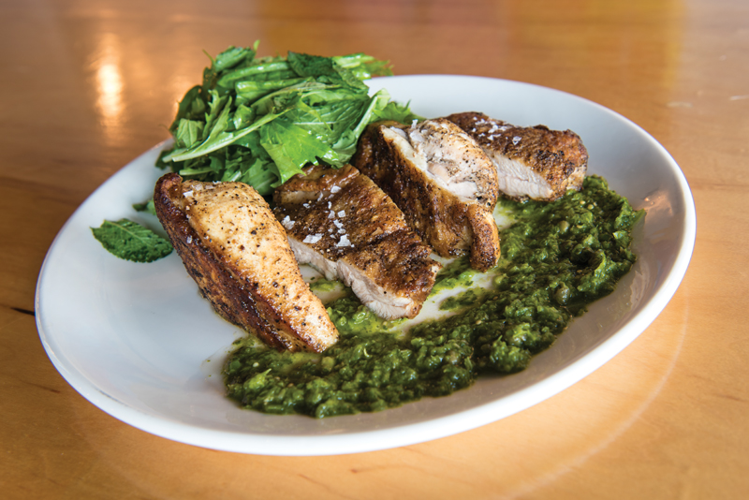
Gazpacho
Little Octopus, the new venture from the team behind Otaku South, is more sophisticated than its predecessor. But it's just as good. In fact, as much as I have always relished the ramen-centric cuisine of Otaku South, Little Octopus is even better.
Instead of drawing inspiration only from the rich broth of Japanese izakaya tradition, Little Octopus chef Daniel Herget (a Johnson and Wales grad who comes to Nashville from Miami) cleverly plucks perfect flavors from a range of cuisines — Asian, Latin and Mediterranean — while honoring the influence of classical French technique.
Little Octopus bills its concept as "fresh, clean, vibrant food with global flavors served in small plates." That proves to be an accurate statement. The small-plates approach has been tried in Nashville for years, dating back to the ahead-of-its-time 12South tapas bar Mirror and beyond, but it's been a while since I've seen it deployed so successfully.
Opening seven weeks ago inside POP Nashville — Otaku South impresario Sarah Gavigan's dining space on Gallatin Avenue in East Nashville — Little Octopus has already made a splash among the kind of food fans who try to suss out the city's next hot thing. The POP space was made available to Little Octopus when Otaku South announced it will be moving to a new location in the Gulch this fall.
Little Octopus' press materials describe the menu as "vegetable driven," which is true in the sense that the relatively small menu emphasizes fresh vegetables. But the menu also makes the most of fresh seafood, and there are even a couple of well-crafted beef dishes. The menu's diverse appeal is highlighted by the little acronyms appended to nearly every dish on the list — V for vegan, GF for gluten-free, OL for ovo-lacto (meaning OK for vegetarians who eat eggs and cheese) and P for pescatarian (OK for fish eaters).
But instead of the bland matrix of compromises that alphabetical jumble suggests, the menu delivers everything you'd want in food — the heightened flavors of fresh seasonal ingredients prepared with creativity and skill.
On two recent dinner visits, we took our server's advice and ordered a panoply of dishes for the table to share. She explained that the items would come out in no particular sequence, each delivered as soon as the kitchen completes it.
The menu divides smaller plates into subcategories of "raw," "cool" and "warm." The larger, entrée-approximating dishes are called "plates."
Of the raw list, I particularly enjoyed the hamachi — slices of fresh yellowtail topped with a sprightly dice of green apple with jalapeño and lime juice and an unexpected counter-balance of nutty truffle. (Herget uses a hint of truffle juice, fresh pressed from Burgundy truffles, plus a little diced truffle on top and a small amount of truffle oil.) But the winner of the cool category was a bowl of refreshing, deep-green gazpacho, made with seedless cucumbers, tomatillos, romaine lettuce, roasted grapes and date oil infused with Hungarian paprika.
The warm items were an especially strong slate. The star was a Latin-inspired plate of maduros — sliced plantains roasted to sweet caramelization, accompanied by beautifully tart lime preserves and a sprinkling of Cotija cheese.
The dish of fingerling potatoes was also perfectly roasted to bring out a hint of caramel; they were almost like a spudly version of crème brûlée, served with a side of red chimichurri sauce and what the menu called charred broccoli rabe, but which looked to me more like charred broccolini. Whichever member of the brassica family it was, it was damn good.
As I've said, starters and plates came in no particular order, but at some point we got to the bigger dishes. The most impressive bowl out of the whole array was moqueca, a Brazilian-inspired dish of grilled shrimp atop rice that was almost risotto-like in creaminess, prepared with coconut milk and palm oil. Those ingredients yielded a buttery flavor that reminded me of movie-theater fake-butter popcorn — but in the best possible way. Wonderfully soothing. Since Nashvillians are relatively unlearned when it comes to seafood (the legacy of being landlocked in a smaller city with relatively undeveloped coastal fish connections), perhaps the most daring offering was the plate of sardines. These were no thumb-sized small fry pulled out of a can, but a trio of 6-inch-long fresh fish, grilled and served whole for our delectation.
One of my dining companions is a veteran culinarian and a dab hand at deconstructing fish. She made quick work of separating the tender little fillets from the spine. Some morsels were mild-tasting, others were fishier; all were extremely fine in flavor.
There's an old foodie chestnut that you should never order roast chicken in a restaurant. Why bother paying a pro for something you can easily make at home? Well, stuff that snooty old trope. Chefs can source high-quality fresh chickens; when roasted on the bone, then cut expertly into chunks you can share with friends, roast chicken makes for a lovely and restorative — albeit simple and healthy — meal out. Little Octopus' version is pan-roasted and served with salsa verde and a salad of herbs, well worth the $15.
I have a general policy of avoiding tofu at restaurants — it's so easy for the little block of soybean curd to wind up either bland or overseasoned. But Little Octopus' sumac-crusted tofu gave lie to that assumption. Sumac, the zingy red spice of Middle Eastern provenance, perfectly perked up the tofu. Served with charred eggplant, pea shoots and lemon vinaigrette, it was one of the best vegetarian entrees I've ever had.
And yet in a city surfeit with burgers, Little Octopus' grass-fed patty topped with Manchego cheese was also memorable. I found myself marveling at how such a small menu — only a couple dozen dishes — could cater to so many tastes so successfully, without sacrificing any culinary integrity or unity of vision.
The beverage lineup is similarly diverse: a couple delicious but relatively esoteric cocktails (Armenian brandy, anyone?) and some fairly straightforward wine, beer, sake and cider options. For non-drinkers, there's a daily cold-pressed juice special and a pretty exceptional sparkling lemonade made in house.
The POP dining room is not elaborate, but it seems to get more welcoming over time, with whitewashed walls and a few bright contemporary paintings. As for service, on our visits it was friendly, knowledgeable, and unobtrusive.
I did have to call on some extra help on our first visit. As walk-ins — I had foolishly lapsed into the pre-It City habit of not bothering to make dinner reservations — we were seated at a long center table with barstools. But one member of our party (OK, me) just couldn't get comfortable in the tall chair. At first it seemed like it would be impossible to move, as so many tables were already booked. Eventually, though, the hostess was able to accommodate us. At many Nashville restaurants, nobody would have bothered to go to the extra effort.
If there were any slight glitches, they had to do with the ordering method mentioned above. Everyone at the table orders every course all at once, and each dish shows up in its own time — everybody shares whatever bounty is on the table at the moment.
It was a really enjoyable way to eat overall, as long as your tablemates are game and not stuffy. But one of my dining companions really wanted to have the potatoes on the table at the same time as the sardines. Potatoes are a traditional accompaniment to small fish, to cushion any tiny edible bones that might remain in the flesh. I'm sure the two dishes could have been cued up together, however, if we had simply asked in advance.
And there is one other complication with the sequential serving of many shared dishes. At some point you're going to need a new round of little plates to replace the ones slathered with the sauces of previous courses. It was easy to ask the friendly server for fresh plates and serving spoons, but that probably should be an automatic part of the service.
I was impressed by the reasonable pricing. I already mentioned the $15 chicken, but every dish we ordered was in the $5 to $15 range. While it's also true that we ordered a lot of dishes, we were admittedly curious to try everything. (Plus we're just a bit gluttonous.) A diner of average appetite should be able to enjoy a pretty spectacular meal for no more than what you'd pay at a higher-end chain.
But don't go for the chain. Embrace the Little Octopus instead. And now that word is getting out, you'd better book a table in advance.
Email arts@nashvillescene.com







